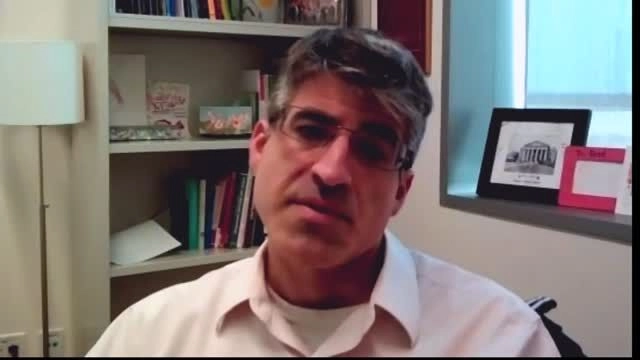Alex F. Herrera, MD of the City of Hope speaks about the ASH 2020 abstract – 472 Consolidation with Nivolumab and Brentuximab Vedotin after Autologous Hematopoietic Cell Transplantation in Patients with High-Risk Hodgkin Lymphoma.
Introducing:
Salvage therapy (tx) accompanied by autologous hematopoietic cell transplantation is the standard of treatment for patients (pts) with relapsed or refractory (RR) Hodgkin lymphoma (HL) (HCT). Most pts with high-risk RR HL can, however, relapse following HCT. The AETHERA study showed that post-HCT consolidation in high-risk HL pts with brentuximab vedotin (BV) improved progression-free survival (PFS) compared with placebo, particularly in pts with 2+ risk factors (Moskowitz, 2018). Pts were omitted from AETHERA with prior BV exposure, and BV is increasingly used in HL prior to HCT. In pts with RR HL and PD1 monotherapy, PD1 blockade is successful as post-HCT consolidation in HL resulted in a positive 18 mo PFSS (Armand, 2019). Combined BV and nivolumab (Nivo) are a safe and successful HL tx rescue, so we conducted a phase 2 multicenter study to determine the safety and efficacy of post-HCT BV-Nivo consolidation in high-risk RR HL.Â
Combined BV and nivolumab (Nivo) are a safe and successful HL tx rescue, so we conducted a phase 2 multicenter study to determine the safety and efficacy of post-HCT BV-Nivo consolidation in high-risk RR HL. Â
Methods:Â
If pts were not refractory, prior BV or PD1 blocking was permitted. Pts underwent HCT at the 5 centers according to institutional requirements. Pts earned 1.8 mg/kg BV and 3mg/kg nivo q21 days for a scheduled 8 cycles from day 30-75 after HCT. The other could be continued if 1 drug was withdrawn due to toxicity. According to the 2014 Lugano classification, investigators evaluated a response and progressive disease (PD). The primary endpoint was 18 mo PFS from the initiation of the tx analysis. Overall survival (OS), protection, and response rate in pts not in full response (CR) at baseline were secondary endpoints.
Outcomes:
59 pts have been enrolled and treated with at least one research dose of tx. Table 1 lists the baseline characteristics. 18 (31%) pts were primary refractory, 35 (59%) had early relapse, 23 (39%) had extranodal dz and 14 (24%) had B sx at relapse, 15 (25%) had > 1 salvage tx before HCT, and 48 (81%) were at HCT in CR. 21 (36%) had 1 AETHERA risk factor adjusted, 23 (40%) had 2 and 14 (24%) had 3+ risk factors. The median follow-up period after the start of the tx study was 15.7 months (range, 2.8-35.5).
Patients began BV-nivo at a median time of 54 days after HCT (range, 34-75) and earned a median time of 8 cycles (range, 1-8). Both 8 cycles of BV and nivo were completed by 29 (49 percent) pts, and 45 (76 percent) patients completed 8 cycles of one medication. 14 (24 percent) pts, including 6 for adverse events (AE), 6 pt withdrawals, 1 pt lost to follow-up, and 1 pt death from PJP pneumonia unrelated to tx analysis, discontinued both BV and nivo early. Due to grade (gr) 3 peripheral neuropathy (PN) in 2 pts, gr 2 PN in 2 pts, carpal tunnel syndrome in 1 pt, gastrointestinal AEs in 2 pts, and infusion induced reaction in 1 pt, BV was discontinued in 8 (14 percent) pts. Due to pneumonitis in 2 pts and colitis, elevated bilirubin, irregular transaminases, elevated creatinine pneumonia, and hypotension with fever in 1 pt, Nivo was discontinued in 7 (12 percent) pts. At 11 (19 percent) pts, 9 pts for PN, and 1 each for neutropenia and arthralgia, the BV dose was reduced to 1.2 mg/kg. The most popular BV-Nivo consolidation-related AEs were PN (51%, 3% gr 3), neutropenia (42%, 31% gr 3-4), fatigue (37%), diarrhea (29%, 3% gr 3), nausea (25%, 2% gr 3), arthralgia (24%), AST elevation (24 percent , 2 percent gr 3). Neutropenia (31 percent), pneumonitis (7 percent), and ALT elevation were the most common 3-4 AEs (5 percent ). In 18 (31 percent) patients, immune-related (ir) AEs requiring systemic corticosteroids occurred. Pneumonitis (12 percent), AST or ALT elevation (8 percent), hypothyroidism (5 percent), and rash were the most common Gr 2 or higher irAEs (3 percent ).
After HCT, 6 pts were not in CR at baseline (all PR). In PR without PD, 5 pts converted to CR with research tx and 1 pt remained. There were only 2 PFS cases, 1 pt with relapse at 15 months, and self-discontinuation of PJP-related death following prophylaxis. In all patients, the median 18-mo PFS and OS were 95% and 98%, respectively. The estimated 18 mo PFS was 92 percent and 89 percent respectively, in pts with 2+ and 3+ risk factors.
Findings:
A promising strategy is a post-HCT consolidation with BV-Nivo in pts with high-risk RR HL, with only 1 relapse reported so far in our cohort with a brief follow-up. While IrAEs were observed more frequently than in the pre-HCT setting and PN and neutropenia were normal, Post-HCT BV-Nivo was tolerable.

